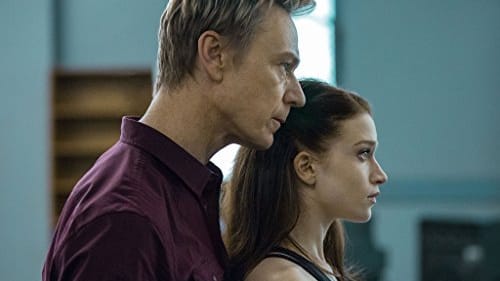Stay in the Loop
BSR publishes on a weekly schedule, with an email newsletter every Wednesday and Thursday morning. There’s no paywall, and subscribing is always free.
‘Black Swan’ Redux
'Flesh and Bone' on Starz

Ballerinas have an identity problem. One identity is the dancer of little girls’ dreams, who spins on top of a music box to a tinny rendition of Swan Lake; the other is the dark, sinister ballerina who, in her doomed quest for perfection, turns into a stressed-out, strung-out anorexic.
The nature of ballet smashes the ideal of the music-box ballerina. In a time-based art demanding an all-or-nothing approach, a ballerina must nurture hunger of the heart and the belly, so that she might claw her way into the spotlight and feast on the accolades from a rapturous crowd. Of course, the spotlight dims and the accolades fade, but ballet offers the promise of greatness, for the mortal to become immortal by living in the imaginations of others.
The clichéd and the tawdry
Starz’s eight-episode Flesh and Bone, created by Emmy-winning Breaking Bad writer Moira Walley-Beckett, fixates on the physical excess and emotional distress exacted by ballet. One part Dancing on My Grave and another part The Jerry Springer Show, Flesh and Bone revels in the clichéd, the sensationalistic, and the tawdry.
The series centers on 21-year-old Claire Robbins (played by a competent if underwhelming Sarah Hay). After an absence from ballet, she auditions for and is offered a contract at the fictitious American Dance Company. Her luminous talent catches the eye of Paul, the artistic director (Ben Daniels, who brings gravitas to the cartoonish character). He wants to catapult his company into prominence, so, in a risky move, Paul scuppers the upcoming gala performance of Giselle in favor of a new ballet created by Toni (Marina Benedict), a hot contemporary choreographer. He’s gambling that this ballet will cast Claire and the company into the limelight.
Like the center of an asterisk, all the characters intersect with the rabidly ambitious Paul, who has two moods: boiling excitability and icy derision. Abandoned by his parents and raised in a foster home, Paul takes his angst out on whomever gets in his way. Targets include Ross (Sascha Radetsky, whose charm has worn thin since his Center Stage days), the playboy principal dancer, who balks at Paul’s suggestively hands-on coaching and company manager Jessica (Tina Benko), who strives to indulge Paul’s demands for champagne on a prosecco budget.
Nothing but a dick . . .
Claire suffers the worst of Paul’s mercurial moods. Toni’s sensual choreography has a triggering effect on Claire due to a past stained by sexual abuse, and she struggles to execute it to Paul’s satisfaction. To shatter her reservations, Paul waves his penis in Claire’s face. As she quivers, he says, “This, my dear, is a dick — nothing more, nothing less.” Then, Paul commands her to go find one of her own, so that she will stop screwing with his livelihood.

Because Flesh and Bone is a Starz production, there’s enough sex, drugs, and boobs for a rock star. The aging prima ballerina Kiira (the deliciously campy Irina Dvorovenko) must cope with her disintegrating body. She swallows pills by the handful and snorts cocaine, all so that she can stay ensconced in the spotlight. As for the sex, pretty much everyone is having it. Mia (Emily Tyra), Claire’s anorexic roommate, has an obscene encounter with Claire’s traumatized brother, who’s returned from Afghanistan. Paul keeps his male lover at arm’s length by paying him, and Claire moonlights at a strip club where, after Paul’s incitement to get over her inhibitions, she has sex with a smitten customer. Rather than titillate, these trysts depress, fueled as they are by loneliness and self-loathing.
. . . and a foot fetish . . .
While myriad boobs fill the screen, it’s really the foot that’s the fetish. Shot after shot lingers on satin-clad feet rising en pointe, the negative space shaped by a graceful arch evoking other erotic bulges. Under these slippers, though, the feet are a bloody, mangled mess. In the first episode, Claire peels off her big toenail before retying her pointe shoes to ace her audition. It’s not just the pointe shoe that suggests dissonance between appearance and actuality; Claire receives a pair of black strappy Louboutins from a wealthy donor, Mr. Brousseau. The camera loiters on her feet, contained in what looks like a kinky cage, and it’s no surprise when Mr. Brousseau presses for sex. Whether designed for pirouettes or parties, these exquisite but treacherous shoes imply the delicate balancing act women must perform between sparking awe and kindling lust.
Most of the female characters are grappling with some type of physical and/or emotional anguish. Claire’s backstory packs the hardest punch. She and her brother Bryan (Josh Helman) had an affair; she got pregnant and gave up their daughter. The nature of Bryan’s predation is never answered satisfactorily. He stalks Claire after she cuts off contact, but during a Thanksgiving visit home, they have consensual sex. Like the passive heroine in a fairy tale, Claire doesn’t save herself from Bryan; instead, Romeo (Damon Herriman), a sweet but mentally ill homeless man, slays Bryan for Claire in a fit of delusional chivalry.
. . . leading to a banal climax
All the storylines twine into a banal climax — the success of American Dance Company’s gala performance. Claire astonishes the crowd in Toni’s contemporary ballet, Daniki, and the American Dance Company places itself on the map. In what should be a subversive ending, Paul congratulates Claire in her dressing room. He drags his fingers down her chest and urges her to tell him everything she’s feeling. “No,” Claire says firmly, an unusual answer for a ballerina used to saying yes. Perhaps we’re supposed to applaud her, but this is ballet. The question of whether Claire dances again lacks dramatic heft because plenty of young, hungry, skinny ballerinas wait in the wings.
The clunky, amateurish choreography (by Ethan Stiefel) of the supposedly groundbreaking Daniki points to the larger issue with Flesh and Bone. It desperately wants to be provocative and innovative, but it isn’t doing anything that hasn’t been done before. Toni’s first rehearsal for Daniki features the dancers with bare feet, an African drummer, and lots of rolling on the floor — modern dance clichés to be sure, but at least at odds with classical ballet. By the next rehearsal, it’s back to ballet as usual: pointe shoes, sweeping lifts, and pretty port de bras.
It’s this failure to transcend the lurid, hackneyed bromides of ballet, in both story and art, that makes me wonder: Does anybody have anything new to say about ballet?
What, When, Where
Flesh and Bone. Created by Moira Walley-Beckett. Available at Starz on demand, via Amazon, and on DVD.
Sign up for our newsletter
All of the week's new articles, all in one place. Sign up for the free weekly BSR newsletters, and don't miss a conversation.

 Erin Bomboy
Erin Bomboy